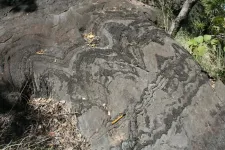(Press-News.org) A new study reveals how the brain’s "place cells" create internal maps to help us navigate. These specialized neurons, found in the hippocampus, were once thought to rely on precisely ordered patterns for spatial coding. However, researchers have found that their activity, which appears disordered in large spaces, actually follows universal mathematical principles. This surprising discovery suggests that randomness, not strict organization, is key to how our brains encode information about our experiences. The findings could reshape our understanding of brain function and pave the way for new insights into how we represent and process complex information.
[Hebrew University of Jerusalem]– A new study led by Prof. Yoram Burak of the Edmond and Lily Safra Center for Brain Sciences and the Racah Institute of Physics at the Hebrew University of Jerusalem unveils a unifying mathematical framework to explain how place cells in the hippocampus encode spatial information across diverse species and environments.
Place cells are specialized neurons in the hippocampus that help animals navigate by creating firing patterns that encode locations within the animals’ surroundings. Traditionally, these cells were thought to fire in single, compact regions of space with a stereotypical symmetric shape. However, recent research has revealed that in larger environments, these cells display much more complex and irregular patterns of activity, firing in multiple locations with varied shapes and sizes.
Prof. Burak’s team has found that a remarkably simple yet powerful mathematical model explains the irregular firing patterns of place cells in large environments. The model is based on the concept of “Gaussian Processes”, a class of random functions that play an important role in diverse natural phenomena ranging from cosmology to oceanography. In the model, firing regions of place cells emerge by marking regions of space in which a random Gaussian process crosses a certain threshold. Using this simple model, the researchers showed that the activity of place cells in bats and rodents across 1D, 2D, and 3D spaces follows universal principles. These findings imply that these patterns arise from largely random inputs to the hippocampus, challenging the idea that the brain relies on precise organization for its spatial map.
“Our findings suggest that randomness, rather than specific design, governs the synaptic organization of inputs to CA1 neurons in the hippocampus,” explains Nischal Mainali, a student at the Hebrew University and one of the authors of the study. This perspective challenges long-held assumptions about the structure of neural circuits and opens new avenues for understanding spatial cognition.
The model also makes precise testable predictions about the arrangements of place cell firing fields, and their geometry, which were verified by re-examining recordings of place cell activity, collected in previous experiments from bats, mice, and rats that navigated in diverse environments.
These insights not only shed light on the neural mechanisms of spatial navigation but also provide a foundation for exploring how the brain encodes information. Prof. Burak explains: “The seemingly random firing patterns of place cells in large environments form ‘codewords’ that are uniquely assigned to different positions in space. We believe that the brain tunes the statistics of these random codewords to create a very efficient representation of positions in large environments”.
END
The brain’s map of space: A new discovery about how our brains represent information
2025-02-24
ELSE PRESS RELEASES FROM THIS DATE:
AI to diagnose invisible brain abnormalities in children with epilepsy
2025-02-24
Scientists have developed an AI-powered tool that detects 64% of brain abnormalities linked to epilepsy that human radiologists miss.
MELD Graph is an AI tool that could drastically change the care for 30,000 patients in the UK and 4 million worldwide with one cause of epilepsy, researchers say.
The study, published today in JAMA Neurology by a team at King’s College London and University College London (UCL), shows how the tool significantly improves the detection of focal cortical dysplasia’s (FCDs) which is a leading cause of epilepsy.
Researchers say the tool will speed up diagnosis times, get patients the surgical treatment ...
COVID-19 vaccination and odds of post–COVID-19 condition symptoms in children ages 5 to 17
2025-02-24
About The Study: The results of this study suggest that mRNA COVID-19 vaccination may be a protective factor against post–COVID-19 condition in children following SARS-CoV-2 infection. These findings suggest benefits of COVID-19 vaccination beyond those associated with protection against acute COVID-19 and may encourage increased pediatric uptake.
Corresponding Author: To contact the corresponding author, Anna R. Yousaf, MD, email pgy6@cdc.gov.
To access the embargoed study: Visit our For The Media website at this link https://media.jamanetwork.com/
(doi:10.1001/jamanetworkopen.2024.59672)
Editor’s Note: Please see the article for additional ...
Sudden cardiac arrest among young competitive athletes before and during the COVID-19 pandemic
2025-02-24
About The Study: This cohort study found no increase in sudden cardiac arrest/sudden cardiac death in young competitive athletes in the U.S. during the COVID-19 pandemic, suggesting that reports asserting otherwise were overestimating the cardiovascular risk of COVID-19 infection, vaccination, and myocarditis. Many athlete cases shown in social media video montages occurred before the pandemic yet claimed COVID-19 infection or vaccination raised the risk of sudden cardiac arrest/sudden cardiac death.
Corresponding Author: To contact the corresponding author, Jonathan A. Drezner, MD, email jdrezner@uw.edu.
To access the embargoed study: Visit our For The Media website at this ...
Mortality among US physicians and other health care workers
2025-02-24
About The Study: The results of this cross-sectional study suggest that although physicians and most health care workers experienced lower mortality rates compared with the general population, this benefit did not fully extend to female individuals or racial and ethnic minority groups. Renewed efforts are needed to address health inequities within the health care workforce.
Corresponding Author: To contact the corresponding author, Anupam B. Jena, MD, PhD, email jena@hcp.med.harvard.edu.
To access the embargoed study: Visit our For The Media website at this link ...
Telemedicine adoption and low-value care use and spending among fee-for-service Medicare beneficiaries
2025-02-24
About The Study: In this cohort study, telemedicine adoption was associated with modestly lower use of 7 of 20 examined low-value tests (most point-of-care) and no changes in use of other low-value tests, despite a small rise in total visits that might offer more testing opportunities. Results suggest possible benefits of telemedicine and mitigate concerns about telemedicine contributing to increased spending.
Corresponding Author: To contact the corresponding author, Ishani Ganguli, MD, MPH, email iganguli@bwh.harvard.edu.
To access the embargoed study: Visit our For The Media website at this link ...
Researchers find telemedicine may help reduce use of unnecessary health tests
2025-02-24
Low-value care—medical tests and procedures that provide little to no benefit to patients—contributes to excess medical spending and both direct and cascading harms to patients. A research team from Mass General Brigham and their collaborators have found that telemedicine may help to reduce the use of low-value tests. The work is published in JAMA Internal Medicine.
“In theory, widespread adoption of telemedicine post-pandemic may influence low-value testing—such as Pap smears and prostate cancer screenings in older adults, and imaging scans for straightforward cases of low back pain,” said lead author Ishani ...
Research provides new detail on the impact of volcanic activity on early marine life
2025-02-24
Analysis of fossilised rocks known as stromatolites from more than two-and-a-half billion years ago has provided new insights into the conditions on Earth before the evolution of oxygen.
Led by Northumbria University researcher, Dr Ashley Martin, an international team with expertise in geology, microbiology, and geochemistry, worked in partnership to investigate nitrogen cycling patterns within ancient stromatolites, preserved in southern Zimbabwe.
Nitrogen is vital for all life on Earth but must first be converted into useable, bioavailable, forms as it passes through the atmosphere, soil, plants and animals in the nitrogen cycle.
The team believe the unusual nitrogen ...
NCSA awarded funding to continue AI-focused NSF REU program
2025-02-24
The National Center for Supercomputing Applications received funding from the U.S. National Science Foundation (NSF) to renew its annual Research Experience for Undergraduates (REU) program, the Future of Discovery: Training Students to Build and Apply Open Source Machine Learning Models and Tools (FoDOMMaT).
Housed in NCSA’s Center for Artificial Intelligence Innovation (CAII), the 10-week on-site experience brings about 10 undergraduate students each year from a variety of academic backgrounds to the University of Illinois Urbana-Champaign campus to engage in cutting-edge machine learning and deep learning projects, developing ...
New USF study identifies urgent need to protect coastal marine ecosystems
2025-02-24
TAMPA, Fla. (Embargoed until Feb. 24, 2025) – A new study led by the University of South Florida highlights the urgent need to protect marine ecosystems in shallow water near the shore – an area that many beachgoers don’t realize is highly important to fish populations. Known as tidal flats, these coastal waters are critical to global seafood supplies, local economies and overall marine health.
The findings from a team of interdisciplinary marine experts, “Habitat management and restoration as missing ...
Mega-iceberg from Antarctica on collision course with South Georgia: harbinger of things to come?
2025-02-24
It is no strange sight to see icebergs break off of the Antarctic ice cap and drift away, like the gigantic sheet of ice that is currently heading for the island of South Georgia. But climate change is making it happen more frequently, with ever-larger icebergs in the waters around Antarctica. Researchers from Utrecht University are studying the routes that icebergs followed during geological periods of rapid ice cap deterioration, such as the ends of ice ages. That provides crucial information about the effect of melting icebergs on the oceans, and its consequences for the future. In the process, ...


